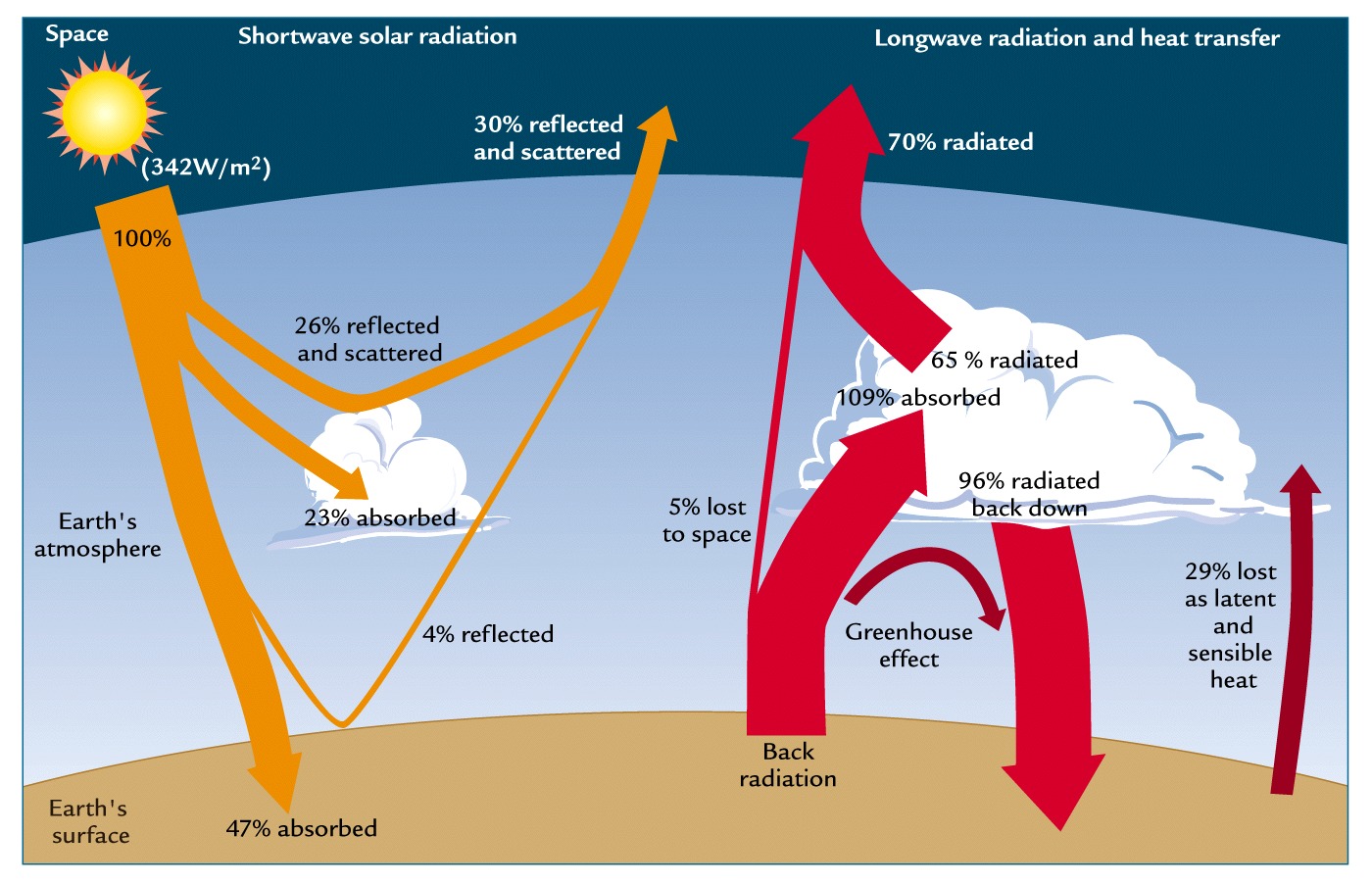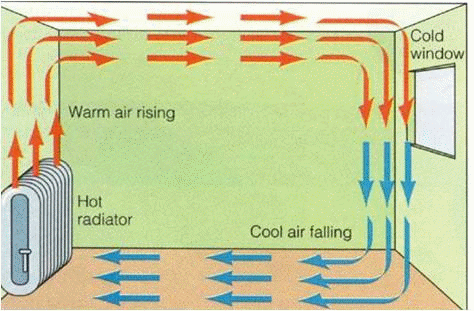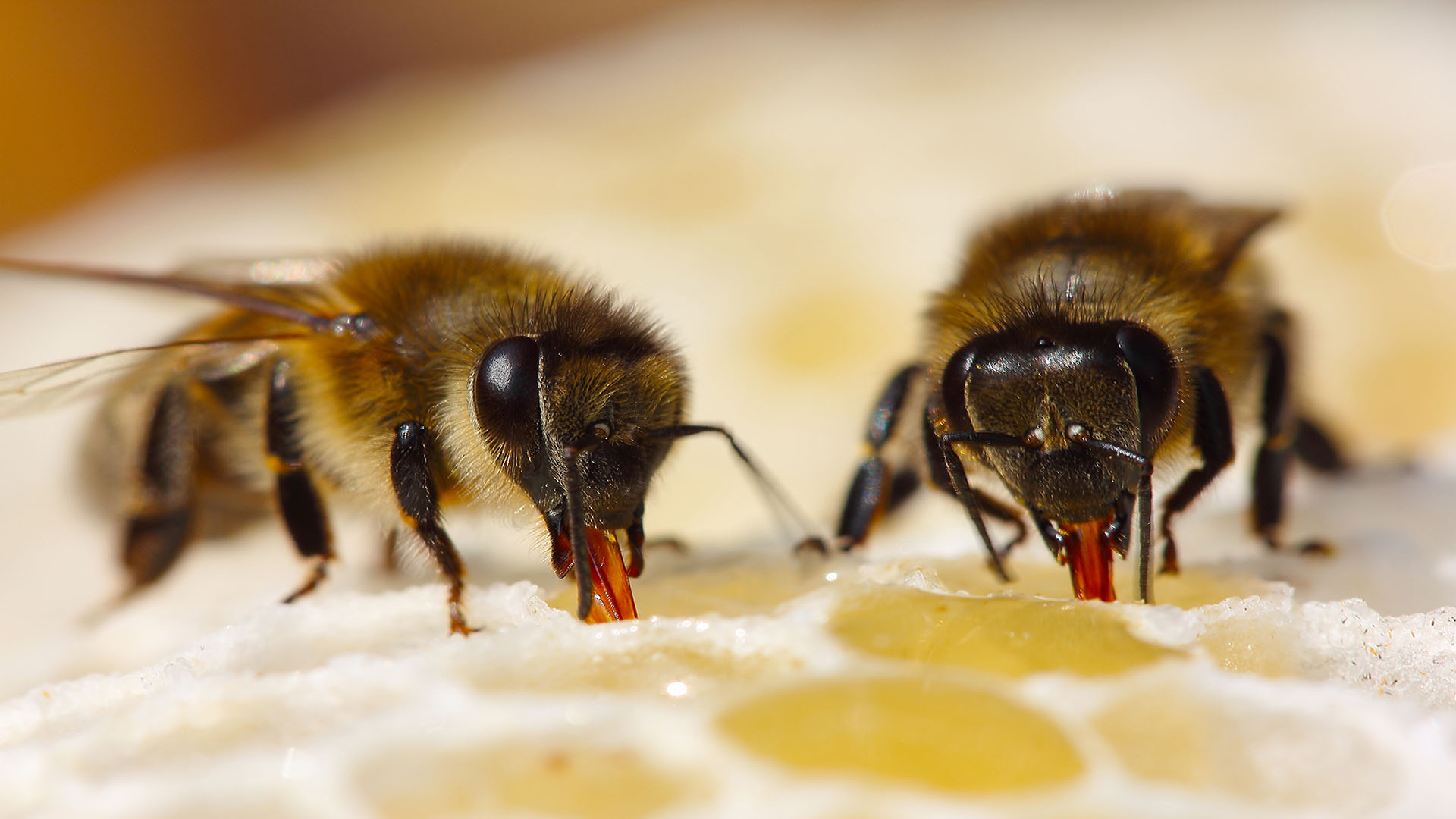Thermal Energy Efficiency and Honey Desiccation
- Posted
Energy-Intensive Process
Honey ripening or desiccation of nectar to produce honey by honeybees is an energy-intensive process, as it involves a change in the concentration of sugars in the nectar from typically 20 to 80% by vaporization and its modification by the secretion of enzymes. After collection from numerous flowers, sometimes at the considerable distance of 1–9 km (0.6-5.5miles), the nectar in the foragers crop (“honey stomach”) is passed to another honeybee, an unloader/storer, which starts the desiccation process by selectively heating and aerating the nectar with their mouth parts, while placing it in a honeycomb cell. This partially desiccated nectar is then exposed to low humidity air through increased temperature, while the hive population engages in vigorous forced air movement within the nest by fanning their wings. The first part of the process lasting a few minutes and the second part, a few hours up to a few days. The efficiency of this process is vital for the honeybee colony to survive periods when no nectar is available, especially during winter. Honeybees do not hibernate in winter but use the stored energy in the honey’s sugars to maintain temperatures above 18°C (64°F) for some of the colony, and above 10°C (50°F) for the remainder, when temperatures outside the nest enclosure can be as low as −40°C (-40°F).
The amount of removed water vapor produced and managed by the colony is significant over the non-winter months. If the foragers bring in 100 lbs. of nectar it will be desiccated down to 25 lb. of honey (2 gal), thereby evaporating 75 lb. of water (9.3 gal) into their nest environment. This is no easy task and considerable amounts of energy are required to achieve this. It can take 36 watts or the heat of a small candle to evaporate 1 lb. of water in an hour. Increased humidity as desiccation proceeds must also be addressed through thermoregulatory temperature transitions. Temperature increases are generated to “dry” the air and reduce relative humidity (RH) which are then followed by rapid decreases towards the end of the evaporation phase. This energy-intense environment regulations are a normal, routine operation in the nest.
Nest to Foraging
Since the honeybees generate heat by the vibration of their wings the distance flown from the nest to the forage areas are also factors in nectar desiccation and energy consumption. The foragers use some portion of the nectar they collect to replenish the transport energy they have lost while flying flower-to-flower. Overall, the portion of the nectar left in their stomachs begins the desiccation process and modification through their stomach enzymes. It is believed that Northern European honeybees in a temperate climate that nectar concentration during flight do not occur because most of the heat generated is used for their own internal thermoregulation. This contrasts in hot arid climates, where energy is gained in flight from the air and insolation (solar radiation).
Nest Configuration
While insolation (solar radiation) may input energy in high thermal conductance thin-walled man-made hives in full sun to reduce the metabolic heat generated by the honeybees for desiccation requirements this is not the case in shaded, very low thermal conductance tree nests. In both types of nests, in temperate climates, vigorous nectar evaporation takes place at night. Thus, we may rule out insolation as a necessity for desiccation. Thus, to reduce honeybee energy expenditure and resource consumption, conduction and advection are the factors impacting their metabolic heat generation.
Given the above analysis, one may discount the outside environment as being a major contributor of energy to desiccation and is instead more likely to be a potential cause of energy loss. Thermal efficiency of nectar desiccation is then dependent on the natural behaviorally selection by the colony of a lower nest conductance, the maintenance of an average temperature difference between the inside and outside of the nest, and the regulation of water vapor and resulting RH. This control of their extended phenotype (nest) allows the honeybees to profitably retrieve nectar and refine to honey from either a strong close nectar source or a weaker nectar source (higher water content) from a greater distance (poor foraging opportunities).
Thermal Energy Efficiency (TEE)
What is the thermal energy (heat) efficiency within the bounded system of the nest enclosure in which heat loses are determined by the conductance of the nest, and the outside temperature and the journey to and from the flower patch from the nest by the forager? How efficient is the system in minimizing the use of costly resources that are utilized to properly thermoregulate the nest?
As mentioned above, the thermal efficiency of nectar desiccation is dependent largely on the conductance of the nest, the average temperature difference between the inside and outside of the nest, and the rate of water being evaporated. Understand that the thermal conductance also includes the internal and external convective heat transfers, as well as the conduction through the internal nest itself. Both are dependent on heat flow velocity and nest geometry which are improved with high tall ceilings, low small entrances, and low thermal conductance walls.
We do know that if the outside temperature is above the internal nest temperature, then the thermal efficiency will be greater than 1, because there is heat gain rather than loss. Fluctuations between these two temperatures will be impacted mostly by the hive wall conductance. Wide temperature swings, which are normal in early rainy spring weather can greatly increase energy lose needed for both brood rearing and honey desiccation through thermal conductance in a system where the nest is constructed of thin-walled material verses thick-walled tree cavities or well insulated hives.
Honey Ripening (Desiccation)
one can clearly see that the process of nectar desiccation into honey is a significant proportion of the energy collected by the honeybees and that TEE and consequently nest thermal conductance are significant factors in their energy collection. One of the results of a proper nest system is that higher internal ambient temperatures are generated through the constant honey ripening rate. This would give rise to a higher TEE allowing the honeybees to profitably forage on lower concentrations of nectar likely available in the early spring provided the RH was not raised as well.
A recent study has shown that by decreasing hive thermal conductance (better insulated) gave rise to an improvement in thermal efficiency, which in turn gives rise to an improvement in honey energy margin (HEM), which allows more nectar to be desiccated to honey. HEM is the balance between the energy within what is collected, and the energy expended in gathering and desiccation. If this goes to zero or breakeven then as you can guess they cannot accumulate the stores needed for times of increased brood production, dearth, droughts, poor weather, and winter leading to eventual starvation as they work themselves to death.
Thus, you would expect that decreases in hive conductance will improve honey yields. This has been shown to occur in practice, in both formal studies and anecdotally, to give increases of up to 30% in yield. This was seen in the improved TEE of expanded polystyrene hives which have half the thermal conductance of wooden hives. Natural tree nests are also half of the thermal conductance of polystyrene hives indicating that bees prefer more insulation in building the most effective TEE system.
Relative Humidity (RH)
As the temperature of the desiccating air within the nest is increased, its water carrying capacity is increased. We may consider how moist our southern states seem in the hot temperatures of the summer. Because the heated air is holding onto more water vapor less air needs to be moved (fanning) to remove the same mass of liquid water from the ripening honey. This temperature increase, therefore, improves the honeybee’s TEE. If TEE was an evolutionary driver of honeybee behavior, we may expect the nectar desiccation process to take place in a part of the hive, where it takes less energy to maintain a higher temperature. This is shown by honeybees preferentially depositing nectar in the upper portions of their nest, i.e. above the brood nest. The temperature stratification above the heat source of the temperature-controlled brood area, reduces the heat requirements and air movement energy for honey production. Also, the insulating properties of empty comb enable losses to be reduced away from the walls of the nest which aligns with the behavior of depositing nectar on combs not facing the outside walls.
The requirement to retain elevated temperatures, and hence reduced RH where the desiccation is taking place, shows an all-year-round advantage for nests with low thermal conductance. This would drive honeybees to seek out such nest sites as tree hollows rather than ground crevices, with lower thermal conductance values (thick wooden walls, bottom entrances) and modify, where possible, nest sites to further reduce the conductance value by, for example, closing holes with propolis.
Conclusion
Improved TEE results in more energy being stored as honey, and therefore increased honey yields for a given colony size and forage area, which not only improves the chances of survival, but it can also improve the availability of some honey for the beekeeper. Consequently, TEE is a key parameter in honeybee population and foraging success. This may also point to ways for beekeepers to increase yield and even revenue by working in a cooperative manner with the honeybee’s natural behavior to improve thermal efficiency by changing their hives to ones which lose less heat and facilitating honeybee behaviors for bottom entrances. For bee keeping, it validates the summer benefits of a key hive design parameter, hive thermal conductance, and gives a sound theoretical basis for improving honey yields, as seen in expanded polystyrene hives.
Glossary
- Insolation – Exposure to the sun’s rays; solar radiation that has been received.
- Radiation – the emission or transmission of energy in the form of waves or particles through space or a material medium.

- Insulation – Material used in insulating; to separate from conducting bodies by means of nonconductors so as to prevent transfer of electricity, heat, or sound.

- Advection – often serves as a synonym for convection. More technically, convection applies to the movement of a fluid (often due to density gradients created by thermal gradients), whereas advection is the movement of some material by the velocity of the fluid.

(image source mecholic.com)
- Convection – single or multiphase fluid flow that occurs spontaneously due to the combined effects of material property heterogeneity and body forces on a fluid, most commonly density and gravity.

- Conduction – The transmission or conveying of something through a medium or passage, especially the transmission of electric charge or heat through a conducting medium without perceptible motion of the medium itself.

- “Extended” Phenotypes – are commonly thought of as physical structures, such as spider webs, beaver dams, termite nests, and honeybee hives where the phenotype is the fitness of the construction for survival and reproduction of the organism. A honeybee’s phenotype is understood to be the observable characteristics or traits of an organism that are produced by the interaction of the genotype and the environment–the physical expression of one or more genes.
Referenced Materials
- Thermal efficiency extends distance and variety for honeybee foragers: analysis of the energetics of nectar collection and desiccation by Apis mellifera
- Honeybees save energy in honey processing by dehydrating nectar before returning to the nest
- Energetic Optimisation of Foraging Honeybees: Flexible Change of Strategies in Response to Environmental Challenges
- Honeybees save energy in honey processing by dehydrating nectar before returning to the nest
